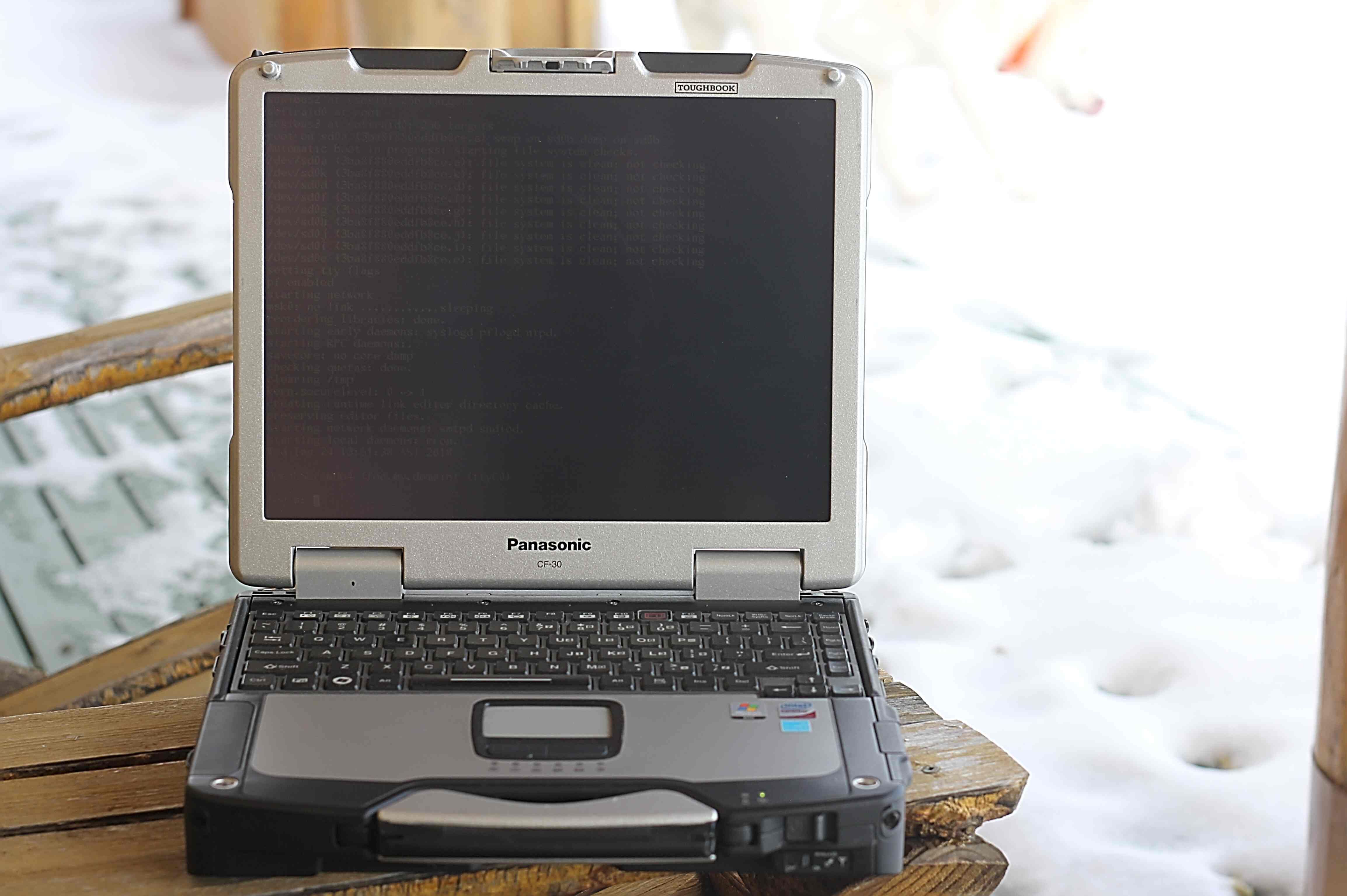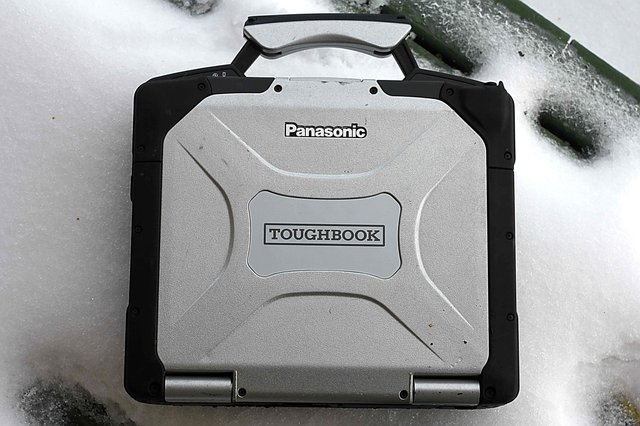Review: The Classic Panasonic Toughbook, CF-30

If you've never seen or used a Toughbook, you're missing one of the great computing treats. For decades, Panasonic has produced a line of ultra-tough notebooks, for use in environments where all other laptops would fail. They have a range of modern offerings, but I think some of the best value is to be had in their older models.
Take the CF-30, for example. Encased in a magnesium alloy, it's built like a tank. Completely silent, hyper-compatible, FULL of expansion capabilities, the CF-30 is designed for "life or death" computing. It set and upholds many standards in rugged computing, and you'd be hard pressed to find a tougher laptop. Personally, I think it's one of the all time greats. In some circles it undeniably has a cult-like following. Although few of us will actually rely on a computer for our lives, why not use top end gear? If you're willing to make a few sacrifices, you can do just that!
My first real computer was an 8088 with a monochrome amber screen. I remember when PS/2 connectors were "the new thing." I've used many, many computers, and this is EASILY one of my favourites.
The CF-30 is a 2007-era model laptop, sporting a Core2Duo processor (around 1.6GHz) and a maximum of 4 GB RAM. It retailed for around USD $4,500.00+ in its day. Today, they can be had for $300.00 -500.00 or less, through the used and refurbished market. The CF-30 is not going to win any speed contests, but it is perfectly usable for most tasks. Its relatively low performance comes with the benefit of low power consumption. When you need six or eight hours of batteries, or where you're off grid and every watt counts, the CF-30's power sipping 30 watts of peak utilization are a welcome statistic!
An Accidental Infatuation
I never really intended to "get into" Toughbooks. I needed a second, low power computer, and happened to find a good deal on a Toughbook. The idea of buying a $4500.00 computer for $300.00 was too fun to pass up, so I bought one. And wow, what a tough, rugged beauty. One became two, and two became four, and what started as a lark has turned into a slick, fairly bulletproof computing environment. Why is it so good?
- They are silent (there are no fans in them.)
- They are drop proof, spill proof, etc.
- They are modular. I can swap drives, chassis, and other components.
- As laptops, they have a built in UPS. Power hiccups do not impact them.
- They are all the same: what works with one works with the rest.
- Everything "just works", all the time
- Low power: 30 watts or so, at max. A consideration, for some.
There are three revisions of the CF-30, the MkI, MkII and the MkIII. Later revisions have slightly faster processors as well as better video (and perhaps the odd other bit.) Physically they are very similar, and components are interchangeable between revisions. Some come with touchscreens, built-in GPS systems, backlit keyboard, and all sorts of other customizations and upgrades. All versions come with middling video cards: these are not meant for gaming, so don't expect to churn out FPS.

These things were designed for hard use, and everything about them shows it. They are IP65 rated (which means they can withstand really dirty environments: even low pressure water jets!)
Modular
The CF-30 is modular. You can swap out a hard drive in about six seconds. Same with the battery. It's built to be repaired quickly in the field, under adverse conditions. I can think of no better laptop for a field technician, for example, or someone who does not have easy access to technical support, or hardware spares.
Mega Interfaces
This is not a netbook! The CF-30 comes with a great number of interface ports. Although they can vary slightly depending on revision and factory configuration, you'll generally find:
- USB
- Firewire
- SD Reader
- PCMCIA/Express Card slots
- Gigabit Ethernet/RJ45
- Modem/RJ12
- 3 x USB
- DB9 Serial
- SVGA Connector
- Speaker/Headphone
- External wifi connector
- Docking Station Connector
- Power Connector (Power supply 100v-240, 15.6v, 2.5a.)
WARNING: There is no HDMI
One thing you'll note is missing: an HDMI connector. If you're going to be hooking one of these up to an external monitor, make sure it has the legacy port. I drive a 1920x1080 external monitor with nary a problem, but some of the newer monitors may not have the old school VGA connector. This is a deal breaker for some people, obviously.
For Best Results
While these things are wonderful computers, overall, you must keep in mind their limitations. They are not for gaming, video editing, or high end graphics work. Anything that requires serious CPU power is going to tax this machine. However, if your expectations of this machine are reasonable, it will not disappoint you. Some things you can do to give your performance a boost:
- Make sure it has the most RAM possible (4GB.)
- Upgrade the drive to a solid state model: this provides a very noticeable performance increase.
- Run a lightweight operating system: I like OpenBSD, but there are many options: Lightweight linux distros, ReactOS, or maybe one of the other BSDs. If you must run Windows, run XP Professional, or Windows 7. Anything beyond that can degrade performance, particularly with the earlier revisions.
I should also note that these machines make nice firewalls. Routers. Wireless access points. Music servers. Excellent backup computers. Quaint little file/web/mail servers. Emulators. They are excellent utility machines, capable of serving many purposes. The removable drive feature can be very handy, allowing you to switch computing environments in seconds.
Compatibility
In technology years, these things have been around forever: you will find drivers in abundance, and mature ones at that. You can expect perfect compatibility with pretty much every modern operating system. I have personal experience with OpenBSD, FreeBSD, six or eight different Linux distributions, Windows 7 (washed my hands afterwards), Open Indiana (Open Solaris), and more. Hardware compatibility had been perfect, every time.
Not For Gaming
Unless your gaming needs are very basic, this is not an ideal computer for gaming (although there are guys out there who are running modern video cards with the Mk3 revisions, via an Express card to PCI card adapter!) The stock video cards are perfectly fine for standard use, but they are not meant for 3d accelerated games, and any modern title with a modern graphics engine is going to run very poorly. That said, you can play a tonne of emulated games as well as games from the era. Games from earlier years run quite well in many cases.
Portable, Convenient, but BIG and Heavy
I don't find the CF-30 to be unwieldy, but it is undeniably huge compared to the sleek laptop models that abound in the small-is-better marketplace. It's never going to be mistaken for an i-Pad, that 's for sure. I find it best sitting on the desk, hooked up to a keyboard and monitor .. although it is kind of a waste. This laptop wants to be on a boat, tucked into a backpack, or possibly used in the deep, dark jungle. It comes with a solid carrying handle: and by solid, I mean "sufficient to hold onto as you dangle over a cliff." The laptop could easily be used as a weapon or a shield: it would not surprise me if these considerations were made during the design phase.
Conclusion
For those of us with non CPU intensive purposes, the Toughbook is one heck of a value proposition. It's got to be one of the most reliable laptops out there, sporting features that are well and truly unique. It's not going to quit on you when you need it most: and hey, if it does, just turn on your other one. After all, they are so affordable, you'll probably want to buy two. Of course, there are many models: if you want something smaller, or more powerful, or with tablet capabilities, Panasonic has a model. Of course, the more modern you get, the more you have to spend.
Full Specifications & A Warning
Below I have provided a link to the manufacturer specifications for an MKIII model. If you are looking at purchasing an MKI or MKII, make sure to take a look at the specifications. They do vary between models and what is applicable to the MKIII may not be applicable to earlier versions. Be careful buying these. There are lots of models. Take the time to read the fine print! Also, these things come with hour clocks, so see if you can find one that has lower hours. Get one with a lit keyboard, too!
ftp://ftp.panasonic.com/computer/toughbook30/toughbook-30_specsheet.pdf
PS I am not affiliated with Panasonic, nor anyone who profits from the sale of Panasonic equipment. I just think this thing is great. Like the IBM Model M keyboard, I think it is one of the finest pieces of computer hardware ever manufactured.
[ @xwalkran ]
Seeking truth, meaning and enlightenment.
Philosophy, Technology, News, Conspiracy, Homesteading, Fiction, $$ and more.
Check out my news/conspiracy aggregation site @ http://walkran.com
Great read. I had no idea that these things had a built-in UPS.
As it turns out, all laptops do!
Wow, you're absolutely right, haha! I just keep imagining UPSes as these bulky power systems, it didn't even strike me that batteries basically do the same thing. ;)
@originalworks
Windows 7 (washed my hands afterwards)... That made me laugh! This is the 3310 of laptops, even with the battery life! Amusing read thanks!
Glad you enjoyed it.
Your Post Has Been Featured on @Resteemable!
Feature any Steemit post using resteemit.com!
How It Works:
1. Take Any Steemit URL
2. Erase
https://3. Type
reGet Featured Instantly – Featured Posts are voted every 2.4hrs
Join the Curation Team Here
Another fantastic post! I'm off right now to try and find an Mk-III. As I'm in Japan it shouldn't be too hard...
Any luck?
Yep, quite a few on the Japanese Rakuten website. Might wait until my next trip to Tokyo, however: might find something better in Akihabara... Just wondering, though: do I need to know my way around Windows in order to install Linux (or other suitable software)?
The only thing you have to do is burn an .ISO image to a dvd, or a usb stick. If you can do that, you'll be able to boot an installer .. which will take you through the installation. It is not hard, and any distribution you download will have instructions on what to do.
Cool. I burnt Trisquel onto a USB for my mac a week or two ago so that should do then. Thanks for all the great help, really appreciate it!
Any time. Interesting choice on the distro! That is a purists choice.